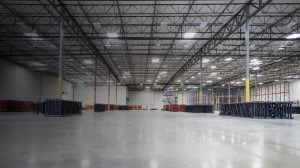

The past few decades have seen a rapid succession of industrial lighting technologies. While LED is here to stay, new innovations have made it more efficient, affordable, and visually effective than ever before.
But there are also more commercial LED options on the market than ever before; it can be difficult for architects and designers to keep pace with the latest products. Which technologies are here to stay, and which are fleeting trends? What products will provide ongoing savings and efficiencies for clients after construction is complete?
When you’re bidding on an industrial design project, understanding the unique challenges facility managers and workers face is the first step to recommending effective lighting solutions. We’ve broken down the key industrial lighting considerations, as well as today’s most promising trends.

All industrial clients will have a few common needs. Any LED solution should, at a minimum, help them with the following challenges.
Fortunately, all of the solutions in the Metalux industrial lighting portfolio are designed to address all three of these needs.
Let’s look at some of the nuanced lighting challenges your industrial clients might face.
Depending on the application, you may need to factor the following considerations into your industrial client’s lighting plan.
Industrial LED lighting fixtures like the Optimized LED High Bay are available in multiple CRI options and feature color temperature tuning, so you can optimize the lighting to suit your space’s needs.
Daylight sensing is another popular feature, helping facilities save by adjusting to natural light levels throughout the day (bonus: this has also been shown to increase worker happiness and productivity.)
Today’s industrial LED solutions can do more out-of-the-box than ever before. The Benchmark High Bay, for example, comes standard with occupant sensing technology and connectivity, for smarter and more automated lighting.
Because of its position and omnipresence, lighting is increasingly being combined with other IoT technologies to improve efficiency, security, data collection, and more in industrial facilities. Here are the trends you’ll likely be hearing more about in the coming years.
Facility managers can’t be everywhere at once, but smarter LED lighting can help them do more. Today’s industrial lighting plays a much larger role than illumination; because lighting is everywhere, a growing number of facilities are leveraging lighting systems to collect key building data for smarter business decisions.
We’ve made it easier for businesses to aggregate and make sense of that data. While facility managers were once burdened with sorting through piles of documents to uncover insights, systems like Trellix put everything at their fingertips. Even the interface is designed for the times; the apps can be used on any device, even on-the-go.
Real-time location systems (RTLS) have become more commonplace in a range of businesses, helping to safeguard inventory, equipment and, in some cases, even people. At its core, an RTLS consists of tags (or “nodes”), sensors, and a wireless technology. Light fixtures are the ideal place for sensors, since it’s everywhere.
In industrial spaces, lighting equipped with RTLS technology can help curb potential losses and improve efficiency. It’s much more difficult for valuable parts or equipment to go missing, and far less time is wasted trying to track things down.
Most facilities want to make the shift from reactive to proactive management, but it’s not easy to get there. Between building maintenance, safety concerns and troubleshooting, there isn’t much time for most facility managers to focus on long-term strategy.
The good news? You can help solve these challenges for clients with the right lighting systems, designed for scalability. You can start with LED lighting solutions (which have many benefits on their own) and gradually add controls and technology that help their facilities evolve.
To learn more about the latest LED industrial lighting trends and how you can help your clients benefit, contact a Cooper Lighting representative today.